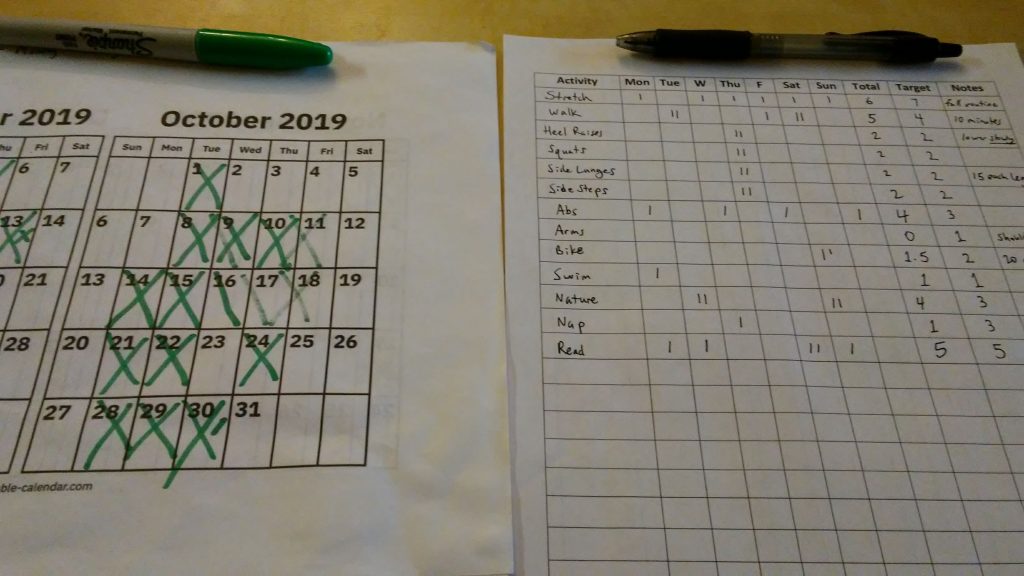
Behavioral change is hard. Luckily, there are strategies that make it easier. One of the best is keeping track of your effort.1 This means finding some way to record how frequently you work toward your goals. Indeed, research has shown that tracking how often you work toward your goals leads to greater progress.
Effort-tracking is effective for four reasons:
1. Process Focus
Effort-tracking helps you keep your eyes on the process, allowing you to stop worrying about the outcomes you haven’t achieved yet. The question you ask yourself each day is: “Did I do my work?” not “Am I there yet?” For example, if your goal is to become more fit, then checking yourself out in the mirror every day isn’t going to help. What will help is keeping track of how often you exercise.
2. Reward
Recording your effort is a way of patting yourself on the back when you do something good for yourself. This gives you a little reward for doing the work, which encourages you to continue. This is critical because long-term goals are often the most important, but they have distant rewards. Effort tracking gives you little rewards along the way, kind of like if you got a piece of candy every time you deposited money in your retirement account.
3. Accountability
Having a record of the effort you’ve done also means having a record of the days when you didn’t put in the work. This forces you to be honest with yourself. Effort-tracking ensures that you don’t delude yourself into thinking you’ve been hustling hard, day after day, when you really haven’t. Sometimes all you need to motivate yourself is the cold splash or a reality check.
4. Evidence of a Better Identity
The flip-side of accountability is that, if you have been working hard, effort-tracking keeps you from wrongly believing that you haven’t. Behavioral change usually involves a shift in identity – something that is notoriously hard because your old identity is deeply entrenched. Effort-tracking is a way to marshal evidence against your old identity in support of your new, improved sense of self. It’s much harder to believe thoughts like, I’m such a lazy piece of crap! when looking at a record of all the effort you’ve been making toward your goals.
How Should You Keep Track?
There are many ways to do effort-tracking, including a growing array of smartphone apps, but I’m old-fashioned. The two effort-tracking methods I love involve pen and paper.
The first is a tool we’ve already discussed here: the calendar chain. This is what I use for simple, single behaviors that I’m committed to doing. For instance, I used a calendar chain to start my meditation habit. And I’m currently using a calendar chain to track my effort on a long-term writing project. There’s a printed calendar that lives on my desk. If I do my writing for the day, I get to put an X in the box.
The second tool I want to offer is something we’ve never discussed here:
The Effort-Tracking Spreadsheet
I developed this tool when I was recovering from several injuries and had a bunch of physical therapy homework to do. I listed the exercises I had to do in the left-hand column of a printed spreadsheet, noted what constituted a minimum dose of each exercise, and set weekly targets. Anytime I did one of the exercises, I put a tick-mark in the corresponding box. It looked like this:

As with putting X’s on my calendar chain, I found that this to be incredibly satisfying. More importantly, when I totaled up each row at the end of the week, I found I was doing far more than I had been before adopting the effort-tracking spreadsheet. Keeping track of my effort caused me to put in more effort.
Since it was working so well for physical therapy homework, I expanded it to include things like reading, time in nature, gratitude journaling, and napping. It worked for these behaviors as well: keeping track of how often I did these things increased the frequency with which I did them.
The effort-tracking spreadsheet can be used for just about anything. I once had a client use one for activities ranging from making sales calls to meditating to practicing guitar. I’ve seen students use them to track the various activities associated with studying for finals.
Here’s a PDF of the effort-tracking spreadsheet, ready for you to print and fill out. (also available on the resources page):
Downloadable/Printable Effort-Tracking Spreadsheet
You don’t have to put down 20 activities each week. Just put down whatever it is you want to do more often. You can divide up a single sheet to cover multiple weeks. Use it however you like.
Similarly, the “Notes” section can be used for whatever you like. Sometimes I use it to write down what counts as a tick-mark (e.g.: “10 reps, each leg” for side-lunges). Sometimes I use it to record details of how to do a particular activity (e.g.: “lower very slowly” for staircase calf-raises). Sometimes I use it to record why I avoided a particular activity (e.g.: “knee pain” for bike riding). Use it however you like.
The Weekly Check-In
A key feature of the effort-tracking spreadsheet is the weekly check-in. At the end of each week, you tally up your rows and record the numbers in the “Total” column. This is an opportunity to compare your totals to the targets you’ve set. You might congratulate yourself if you reached or exceeded your target, but please don’t beat yourself up if you didn’t. Most people, especially when they’re just starting out, set unrealistically high targets.
Alternatively, if you didn’t make your targets, but they aren’t unrealistically high, you can ask yourself, What got in the way? This troubleshooting often leads to better systems – and better outcomes – in the weeks to come.
The check-in is also when you set up next week’s activity list and set new targets. If hitting some targets was easy, you might raise them. If hitting others was difficult, you might lower them. You might add or remove activities from the list. You also might adjust what counts as a minimum dose. For example, if doing 10 pushups counted as a set of pushups, and you found that to be easy, you could increase it to 11. (Notice how I didn’t say increase it to 15 or 20. Gradual growth is the sustainable path.)
We all have good weeks and bad weeks. I recommend the effort-tracking spreadsheet because it gives you a way to celebrate your good weeks and learn from your bad weeks.
Or you can find some other way to track your effort. I’m not sure what type of effort-tracking will be best for you. What I am sure of is this: If you keep track of how often you show up and do the work, you’ll show up and do the work more often.
1 This is an idea that James Clear has been pushing for years. Thanks for the inspiration James! You can find his preferred version of a habit tracker here.
